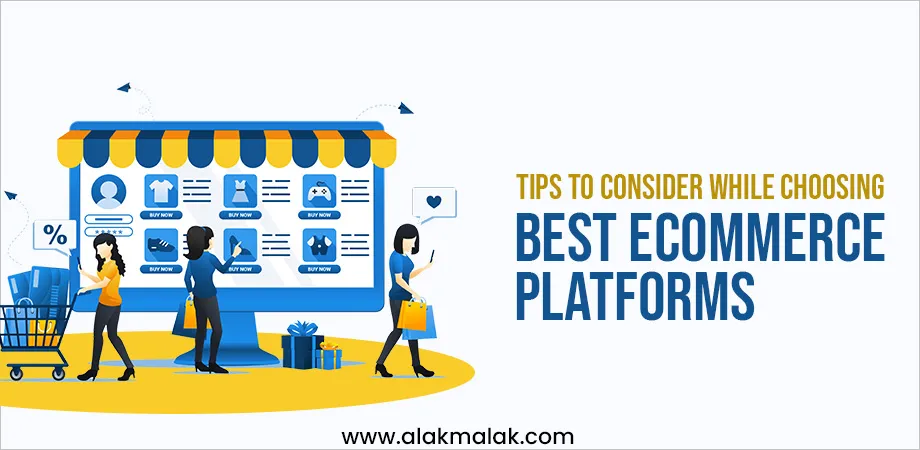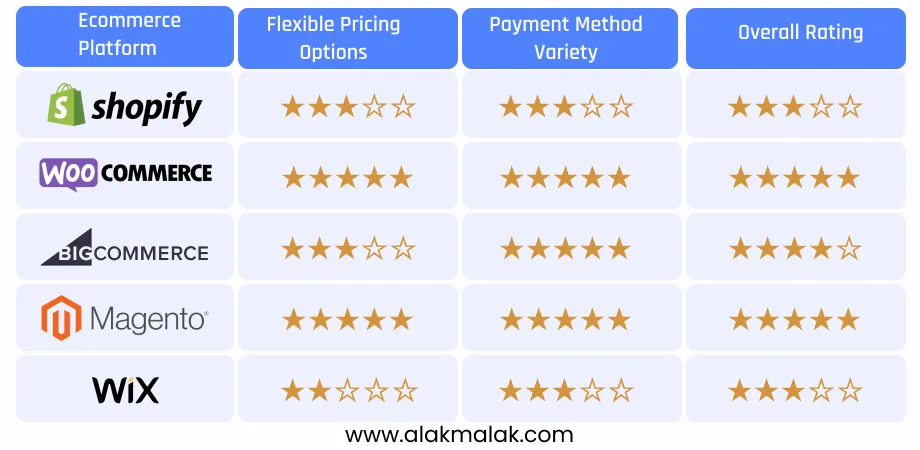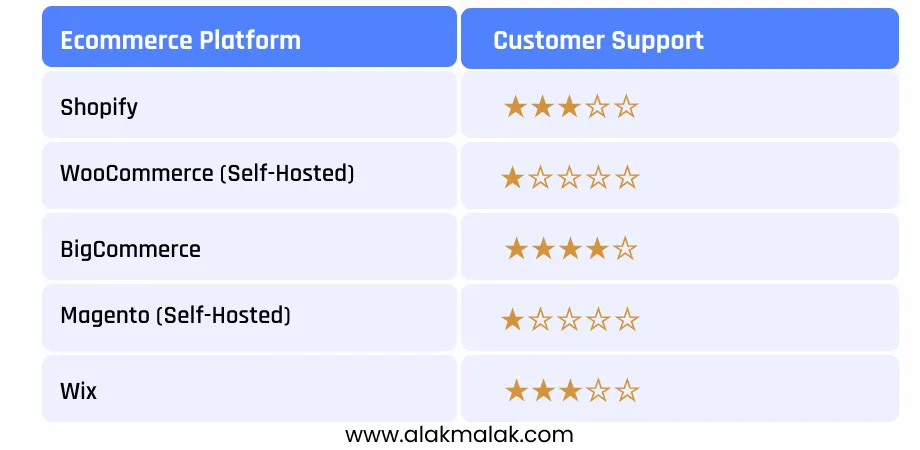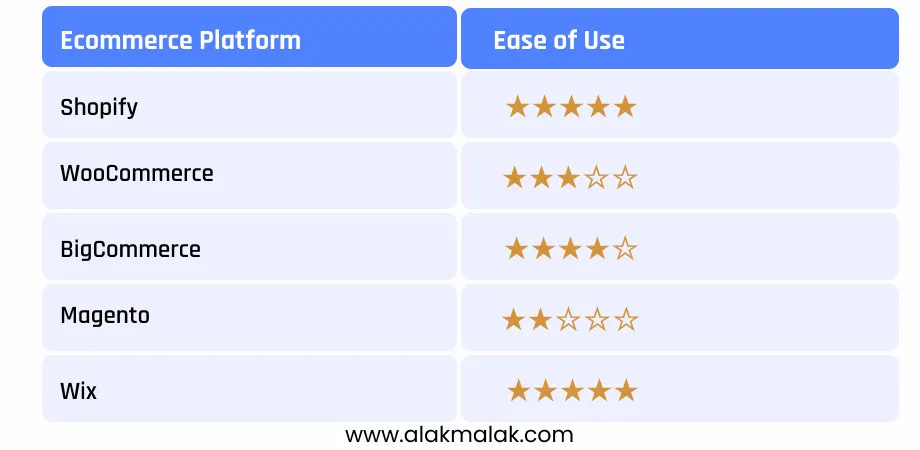In the rapidly evolving world of eCommerce, choosing the right platform for your online business can be a make-or-break decision. With countless options available, it’s easy to feel overwhelmed and uncertain about which platform will best suit your needs. Imagine having the power to streamline your operations, improve customer experience, and skyrocket your sales – that’s the potential of selecting the perfect e-commerce platform.
As an eCommerce website development company in India with 18 years of experience, we understand the challenges and complexities involved in this critical decision. That’s why we’ve compiled the top 7 tips to consider while choosing best eCommerce platforms in the year 2024. By following these guidelines, you’ll be equipped with the knowledge and insights to navigate the ever-changing e-commerce landscape and position your business for success.
Whether you’re a seasoned entrepreneur or a budding startup, this blog post will provide you with a comprehensive roadmap to selecting an eCommerce platform that aligns with your business goals, scalability needs, and customer expectations. Prepare to unlock a world of opportunities by making an informed choice that will propel your online venture to new heights.
Tips to Consider While Choosing Best eCommerce Platforms
1. SEO Friendliness
Search engine optimization (SEO) is a critical factor in determining the online visibility and success of an e-commerce website. In today’s digital landscape, where consumers heavily rely on search engines to find products and services, having an SEO-friendly platform can make or break your e-commerce venture.
Importance:
Neglecting SEO can have severe consequences for your online business. According to a study by BrightEdge, 51% of website traffic comes from organic search, underscoring the significance of ranking well on search engine result pages (SERPs). An SEO-friendly platform can help you attract more organic traffic, improve your online presence, and ultimately drive more sales and revenue.
Implementation:
When evaluating e-commerce platforms for SEO friendliness, look for the following features:
User-friendly URL structures
- Clean, descriptive, and keyword-rich URLs
- Ability to customize URLs for products, categories, and pages
Customizable meta tags
- Ability to edit meta titles, descriptions, and other metadata
- Support for unique meta tags for each page and product
XML sitemaps
- Automatic generation of XML sitemaps
- Easy submission to search engines for better indexing
Integration with popular SEO plugins or extensions
- Support for third-party SEO tools like Yoast, RankMath, etc.
- Seamless integration with analytics and tracking tools
Mobile responsiveness
- Responsive design for optimal viewing on mobile devices
- Separate mobile configurations, if needed
Fast page load times
- Optimized code and caching mechanisms
- Content Delivery Network (CDN) integration
- Lazy loading of images and other assets
By ensuring the e-commerce platform offers these SEO-friendly features, you can effectively implement SEO best practices and improve your online visibility and search engine rankings.
2. Mobile Friendly
In the era of smartphones and on-the-go shopping, having a mobile-friendly eCommerce platform is no longer an option but a necessity. Consumers expect a seamless browsing and purchasing experience across all devices, and failing to meet these expectations can cost you valuable customers and revenue.
Importance:
According to Statista, mobile e-commerce sales are projected to account for 73% of total e-commerce sales by 2025. This staggering statistic underscores the importance of prioritizing mobile friendliness when choosing an e-commerce platform. A platform that is not optimized for mobile devices can lead to poor user experience, higher bounce rates, and ultimately, lost sales.
Implementation:
When evaluating e-commerce platforms, look for the following mobile-friendly features:
- Responsive design: Ensure the platform offers a responsive web design that automatically adjusts the website layout and content to fit various screen sizes and resolutions.
- Mobile-specific themes and templates: Some platforms offer dedicated mobile themes or templates that are specifically designed for optimal mobile browsing and purchasing experiences.
- Touch-friendly navigation: The platform should support touch-friendly navigation, including easy-to-tap buttons, menus, and checkout processes.
- Accelerated Mobile Pages (AMP) support: AMP technology can significantly improve page load times on mobile devices, enhancing the overall user experience.
Additionally, test the mobile experience thoroughly by accessing the platform on various mobile devices and screen sizes to ensure seamless functionality and performance.
3. Pricing and Payment
When it comes to e-commerce, seamless and secure payment processing is crucial for ensuring customer satisfaction and building trust. Choosing an e-commerce platform that offers flexible pricing options and supports a variety of payment methods can significantly impact your business’s bottom line and customer retention rates.
Importance:
According to a study by Baymard Institute, 28% of online shoppers abandon their carts due to a complicated checkout process, which often includes payment issues. Additionally, a report by Worldpay found that offering multiple payment options can increase conversion rates by up to 30%. These statistics highlight the importance of prioritizing pricing and payment features when selecting an e-commerce platform.
Implementation:
When evaluating e-commerce platforms, consider the following pricing and payment factors:
- Pricing models: Look for platforms that offer flexible pricing models, such as flat-rate fees, transaction-based fees, or a combination of both, to suit your business needs and budget.
- Payment gateways: Ensure the platform integrates with popular payment gateways like PayPal, Stripe, and credit card processors to provide customers with convenient and secure payment options.
- Alternative payment methods: Consider platforms that support alternative payment methods like digital wallets (e.g., Apple Pay, Google Pay), buy now, pay later options, and cryptocurrencies to cater to diverse customer preferences.
- Checkout experience: Evaluate the platform’s checkout process for ease of use, mobile responsiveness, and customization options to create a seamless and personalized checkout experience.
- Fraud protection: Look for platforms with built-in fraud detection and prevention measures to protect your business and customers from fraudulent activities.
4. Integrations
In today’s digital landscape, e-commerce businesses rely on a variety of tools and platforms to streamline operations, manage inventory, analyze data, and deliver exceptional customer experiences. Choosing an e-commerce platform that seamlessly integrates with these essential tools can significantly enhance efficiency, productivity, and overall business performance.
Importance:
According to a survey by Ventana Research, businesses that prioritize integrations and data sharing across applications and platforms experience a 25% improvement in operational efficiency and a 17% increase in customer satisfaction. Integrations eliminate data silos, automate processes, and provide a unified view of your business, enabling you to make informed decisions and deliver a cohesive customer experience.
Implementation:
When evaluating e-commerce platforms, consider the following integration capabilities:
- Third-party integrations: Ensure the platform offers out-of-the-box integrations with popular tools and services such as customer relationship management (CRM) systems, enterprise resource planning (ERP) software, accounting software, marketing automation platforms, and shipping carriers.
- Open APIs and developer resources: Look for platforms with well-documented and robust application programming interfaces (APIs) and developer resources, enabling you to build custom integrations or leverage third-party solutions tailored to your specific business needs.
- Integration marketplace or ecosystem: Some platforms offer an integration marketplace or ecosystem, making it easier to discover and connect with a wide range of complementary tools and services.
- Data synchronization and migration: Evaluate the platform’s ability to seamlessly synchronize and migrate data from your existing systems, ensuring a smooth transition and minimizing disruptions.
5. Customer Support
In the fast-paced world of eCommerce, providing exceptional customer support is paramount to building long-lasting relationships with your customers. Choosing an eCommerce platform that offers robust customer support features and resources can make a significant difference in delivering seamless shopping experiences and fostering customer loyalty.
According to a study by Gladly, 92% of customers are likely to purchase again from a company after a positive customer service experience. Furthermore, a report by Zendesk found that 62% of customers are willing to share a negative experience with others, which can severely impact your brand reputation and bottom line. These statistics underscore the crucial role of customer support in driving customer satisfaction and retention.
Implementation
When evaluating e-commerce platforms, consider the following customer support features:
- Knowledge base and self-service resources: Look for platforms that offer comprehensive knowledge bases, FAQs, and self-service resources to empower customers to find answers to common questions and troubleshoot issues independently.
- Omnichannel support: Ensure the platform provides multiple support channels such as live chat, email, phone, and social media integration, catering to your customers’ preferred communication methods.
- Customer support integrations: Evaluate the platform’s ability to integrate with popular customer support tools like help desk software, chatbots, and knowledge base platforms, streamlining your support operations.
- Analytics and reporting: Prioritize platforms that offer robust analytics and reporting capabilities, allowing you to track customer support metrics, identify pain points, and continuously improve your support processes.
6. Ease of Use
In the ever-evolving world of e-commerce, simplicity and user-friendliness are key factors that can make or break your online business. Choosing an e-commerce platform that is intuitive and easy to use can streamline your operations, reduce the learning curve for your team, and ensure a seamless experience for both administrators and customers.
Importance
According to a study by Forrester Research, 93% of businesses cite user experience as a crucial factor in their buying decisions. Furthermore, a report by Gartner found that companies that prioritize user experience and ease of use can increase their revenue by up to 16%. These statistics highlight the significant impact that ease of use can have on your ecommerce business’s success.
Implementation: When evaluating e-commerce platforms, consider the following ease of use factors:
- User interface (UI) and user experience (UX): Look for platforms with clean, modern, and intuitive UI/UX designs that are visually appealing and easy to navigate for both administrators and customers.
- Customization and personalization: Prioritize platforms that offer robust customization options and personalization features, allowing you to tailor the platform to your brand’s unique identity and your customers’ preferences.
- Training and documentation: Evaluate the availability of comprehensive training resources, such as video tutorials, user guides, and knowledge bases, to ensure a smooth onboarding process for your team.
- Third-party support and community: Consider platforms with active developer communities and third-party support resources, enabling you to seek guidance, troubleshoot issues, and leverage best practices from industry experts.
7. Theme Customization and Design
In the highly competitive e-commerce landscape, having a visually appealing and unique online store can set you apart from the competition. Choosing an e-commerce platform that offers robust theme customization and design options can help you create a distinctive brand identity, improve user experience, and ultimately drive more sales.
Importance:
According to a study by Stanford University, 75% of consumers admit to making judgments about a company’s credibility based on its website design. Furthermore, a report by Forrester Research found that a well-designed user interface can increase conversion rates by up to 200%. These statistics underscore the significant impact that theme customization and design can have on your ecommerce business’s success.
Implementation
When evaluating e-commerce platforms, consider the following theme customization and design factors:
- Theme marketplace and customization options: Look for platforms that offer a wide range of pre-designed themes and templates, as well as extensive customization options to tailor the design to your brand’s unique identity.
- Drag-and-drop page builders: Prioritize platforms that include user-friendly drag-and-drop page builders, allowing you to easily create and modify pages without extensive coding knowledge.
- Mobile responsive and adaptive design: Ensure the platform offers mobile-responsive themes and adaptive design features, ensuring a seamless and optimized experience across various devices and screen sizes.
- Third-party integrations: Consider platforms that integrate with popular design tools and services, such as Photoshop, Sketch, or Figma, enabling your design team to create custom themes and designs more efficiently.
Tools and Resources:
- G2 Crowd : G2 Crowd is a popular software review platform that provides in-depth analysis, ratings, and comparisons of various e-commerce platforms. This resource can help you research and evaluate different options based on user reviews and feedback.
- Capterra : Capterra is another valuable resource for finding and comparing e-commerce platforms. It offers detailed software listings, user reviews, and filtering options to help you narrow down your choices.
- Shopify Academy : If you’re considering Shopify as your e-commerce platform, their Academy offers free online courses, tutorials, and resources to help you get started and learn best practices for building and running an online store.
- WooCommerce : For those interested in an open-source e-commerce solution, WooCommerce is a popular plugin for WordPress. Their website offers extensive documentation, tutorials, and a vast community of developers and users.
- HubSpot Ecommerce Resources : HubSpot provides a wealth of free e-commerce resources, including guides, templates, and tools to help you with everything from setting up your online store to optimizing for conversions and marketing your products effectively.
- Google’s E-commerce Guide : Google offers a comprehensive guide to e-commerce, covering topics such as setting up an online store, optimizing for search engines, and leveraging digital marketing strategies.
- E-commerce Blogs and Forums: Stay up-to-date with industry trends, best practices, and insights by following popular e-commerce blogs and forums such as Practical E-commerce, GetElastic, and the Shopify Community Forum.
Case Study
Introducing “Ecofriendly Outfitters” – a sustainable outdoor apparel company that was struggling to keep up with the rapidly evolving e-commerce landscape. Their outdated online store was hindering their growth, and they knew they needed to revamp their e-commerce strategy to stay competitive.
The company’s leadership team thoroughly researched and evaluated various e-commerce platforms, keeping in mind the top 7 tips discussed in this blog post. After a comprehensive analysis, they decided to migrate to a new platform that ticked all the boxes: SEO-friendliness, mobile responsiveness, robust payment options, seamless integrations, exceptional customer support, intuitive ease of use, and extensive theme customization capabilities.
The implementation process was not without its challenges. However, with the help of the platform’s comprehensive documentation, dedicated support team, and a strategic rollout plan, Ecofriendly Outfitters successfully transitioned to their new e-commerce solution within a few months.
The results were nothing short of remarkable:
- SEO Boost: By leveraging the platform’s SEO-friendly features, such as customizable URLs and meta tags, Ecofriendly Outfitters saw a 45% increase in organic traffic within the first year.
- Mobile Excellence: With a fully responsive design optimized for mobile devices, their mobile conversion rate soared by 32%, aligning with the growing trend of mobile commerce.
- Payment Flexibility: By offering multiple payment gateways, including digital wallets and buy now, pay later options, their average order value increased by 22%, and cart abandonment rates dropped significantly.
- Streamlined Operations: Seamless integrations with their CRM, accounting software, and shipping carriers enabled Ecofriendly Outfitters to automate processes, reducing order processing times by 27% and improving overall operational efficiency.
- Customer Delight: The platform’s robust customer support features, including a comprehensive knowledge base and live chat, led to a 35% reduction in support ticket volume and a 20% increase in customer satisfaction scores.
- Brand Identity: Leveraging the platform’s extensive theme customization options, Ecofriendly Outfitters created a visually stunning online store that perfectly captured their brand’s essence, resulting in a 18% boost in brand recognition and loyalty.
Key Learnings:
- Prioritizing the right e-commerce platform features can have a significant impact on your business’s growth, efficiency, and customer satisfaction.
- A well-executed e-commerce platform migration can overcome initial challenges and deliver remarkable long-term benefits.
- Continuously monitoring and optimizing your e-commerce strategy based on evolving customer needs and market trends is crucial for sustained success.
Ecofriendly Outfitters’ success story serves as a testament to the power of choosing the right e-commerce platform and implementing the top tips discussed in this blog post. By prioritizing the key factors, they were able to unlock new growth opportunities, streamline operations, and deliver an exceptional customer experience, solidifying their position as a leader in the sustainable outdoor apparel industry.
Unlock Your Online Success Today!
As we approach the ever-evolving e-commerce landscape of 2024, it’s crucial to make informed decisions when selecting the best platform for your online business. By following the top 7 tips discussed in this blog post, you’ll be well-equipped to navigate the challenges and seize the opportunities that lie ahead.
To summarize the main takeaways:
- Prioritize SEO friendliness to boost your online visibility and attract qualified organic traffic.
- Ensure a seamless mobile experience to cater to the growing mobile commerce trend.
- Offer flexible payment options to increase conversions and reduce cart abandonment.
- Leverage seamless integrations to streamline operations and deliver exceptional customer experiences.
- Invest in robust customer support features to build loyalty and foster long-lasting relationships.
- Choose an intuitive and user-friendly platform to ensure a smooth learning curve and efficient workflows.
- Capitalize on theme customization and design options to create a visually appealing and brand-aligned online store.
Now that you have a comprehensive understanding of the key factors to consider, it’s time to take action. Conduct a thorough evaluation of your current e-commerce platform and assess its alignment with the tips outlined in this blog post. If you identify areas for improvement or recognize the need for a complete platform migration, don’t hesitate to take the leap.
To kickstart your journey toward e-commerce success, we invite you to schedule a consultation with our team of experts. We’ll work closely with you to understand your unique business requirements, provide personalized recommendations, and guide you through the process of selecting and implementing the ideal e-commerce platform for your online venture.
Don’t let the opportunity to thrive in the digital marketplace of 2024 pass you by. Embrace the power of a well-chosen e-commerce platform and unlock new levels of growth, efficiency, and customer satisfaction. Contact us today and let’s embark on a transformative journey that will propel your online business to unprecedented heights.

 By: Rushik Shah
By: Rushik Shah





